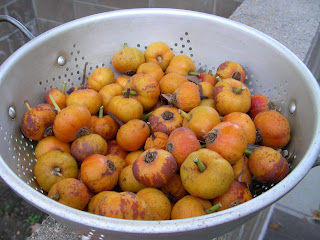Yum, oh YUM! Please pass me some!
I was inspired to make this dish by a cooking demo at the Auburn Farmers' Market a couple of weeks ago. Their FM Association uses produce from the vendors to show folks how easy and delicious veggies can be. Because I wanted to share this yummy dish with Mr. Dwayne, I made one adjustment and that was to leave out the wonderful curry spice mix they used. (Sold at the FM for $5 a jar!) Even without the curry flavor, it is savory, sweet and so good. I've made this twice in the weeks since the demo. It is also an awesome frittata filling. Yum!
Butternut and Kale Saute
1 tbsp. olive oil
2 cups of butternut squash that has been peeled and cubed
1 large shallot, sliced thin
1 cup of apple, peeled and cubed
4 cups of kale that has had the ribs removed and been cut into thin ribbons
About 1/2 cup water or broth
Salt and freshly ground black pepper, to taste
Heat the oil in a large saute pan and add the butternut squash, shallot and apple. Over a medium flame, cook until the squash begins to become tender. Add the water a little at a time, if the squash begins to stick to the bottom of the pan. The steam will help the squash to cook and keep the dish from scorching. Once the squash becomes tender, add the kale ribbons and a little more water. Toss to combine and cover. Let the kale steam for a few minutes until it is tender. Adjust seasoning and serve.
Butternut and Kale Frittata
1/2 cup Butternut and Kale saute
2 eggs
1 tbsp. Greek yogurt
Salt and freshly ground black pepper to taste
2 tbsp. grated Parmesan cheese
Add the veggies to an 8 inch omelet pan with an oven proof handle. If it is not non-stick, add a little butter first. While the veggies are heating, beat the eggs, yogurt, salt and pepper together in a bowl. Add the egg mixture to the pan. Place a rack on the top shelf of your oven and heat up the broiler. Gently lift the edges of the frittata and let the liquid egg run under the cooked part. When the eggs have barely set, but are still runny on top, sprinkle with the cheese and place under the broiler. Broil just until the cheese melts. Remove from the oven and gently tilt and scoot the frittata onto your plate and eat!













